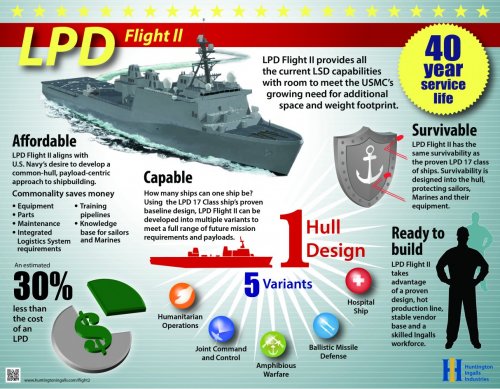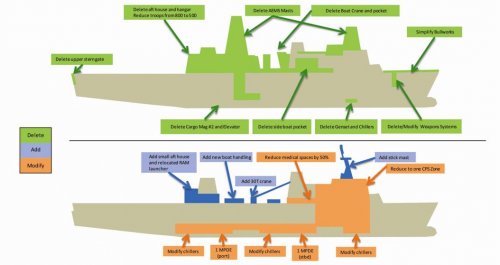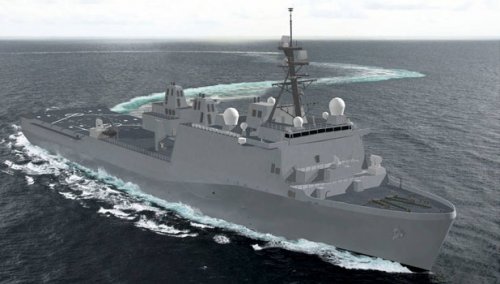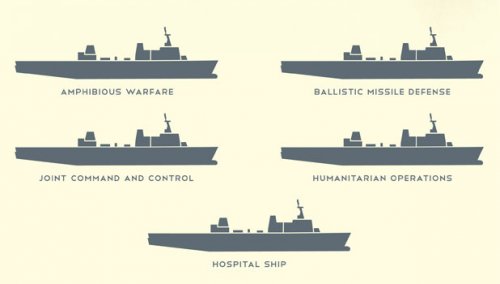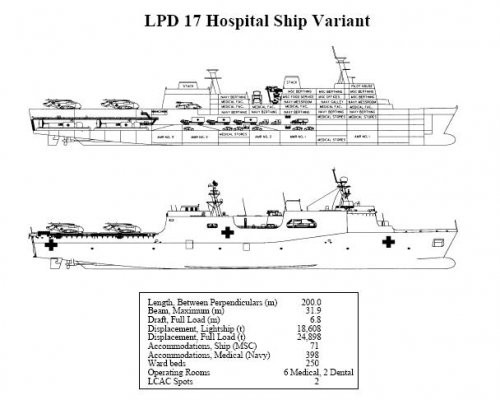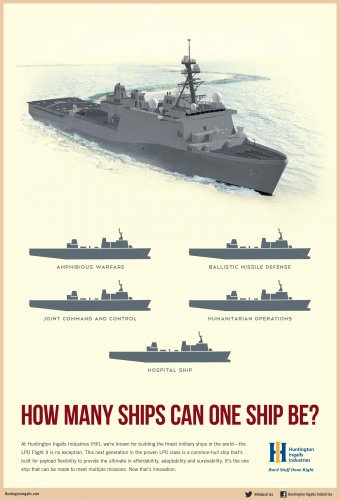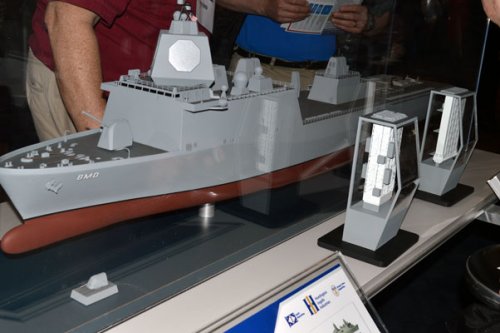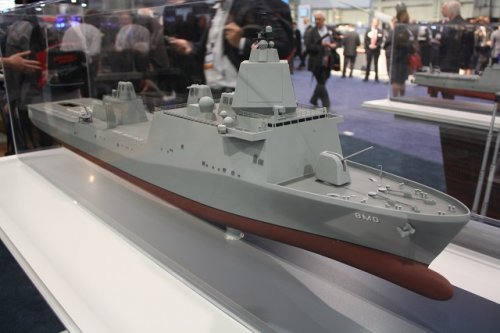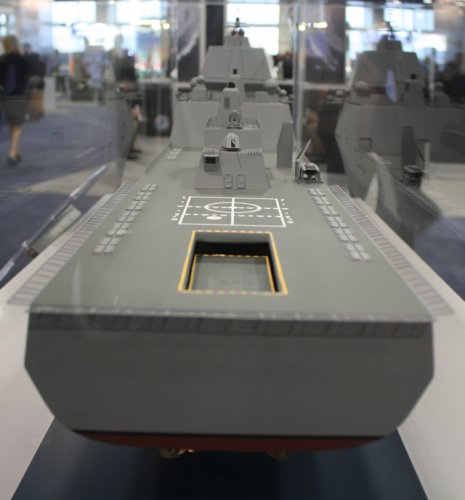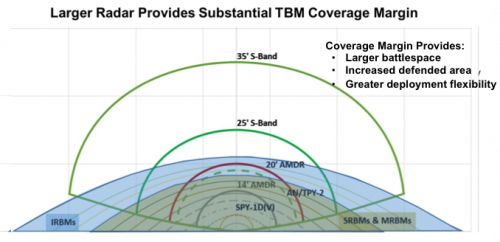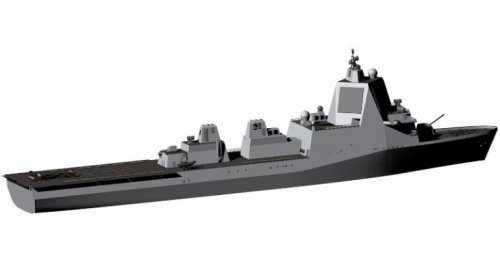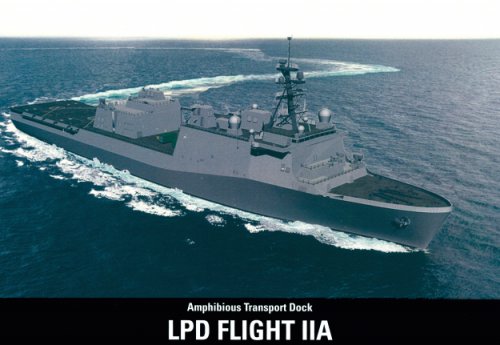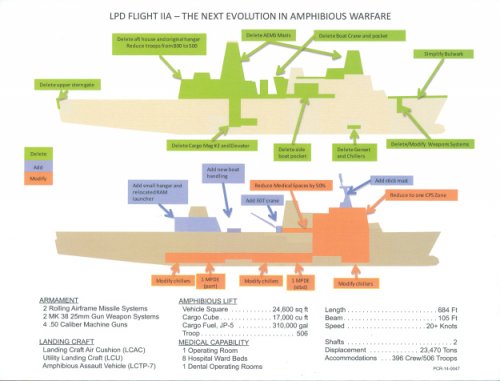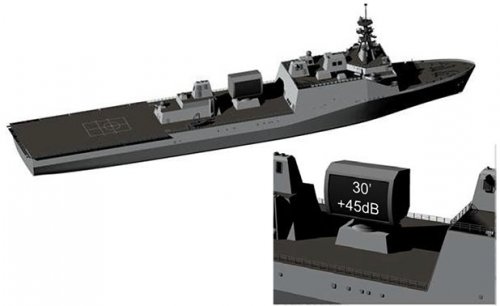You are using an out of date browser. It may not display this or other websites correctly.
You should upgrade or use an alternative browser.
You should upgrade or use an alternative browser.
Huntington Ingalls LPD Flight II
- Thread starter Triton
- Start date
LPD Flight II BMD
http://youtu.be/VxJIizedUsU
Source:
http://blogs.defensenews.com/intercepts/2013/04/hii-shows-off-new-bmd-ship-concept-at-sea-air-space/
http://youtu.be/VxJIizedUsU
An interesting ship model was unveiled April 8 by Huntington Ingalls Industries at the Navy League’s Sea-Air-Space gathering outside Washington: a ship intended primarily for the ballistic missile defense mission.
Using the basic LPD 17 hull designed for the U.S. Navy’s San Antonio-class amphibious transport dock ships — all of which are built by HII — the BMD ship incorporates an Aegis-type phased array radar atop the superstructure. The aft deck, devoid of much of the topside structure of the LPD 17, is ringed by 18 16-cell vertical launch system launchers, for a total of 288 missile cells. Like the existing Mark 41 and Mark 57 VLS launchers in the fleet, the ship’s VLS would presumably be able to launch a variety of weapons, including SM-2, SM-3 and SM-6 Standard missiles, Tomahawk cruise missiles, and other weapons.
Forward on the ship, HII placed a fairly large rail gun mount, a system now under development by the Navy. The model features 57mm guns in mounts similar to those on the Littoral Combat Ships and Coast Guard National Security Cutters, but not the Mk 46 30mm mounts fitted to LPD 17s.
On April 9, HII released a video to show off the new ship:
The seagoing BMD mission currently is filled by cruisers and destroyers carrying the Aegis combat system. Beyond the BMD role, the multi-mission warships can carry out a variety of roles including air warfare defense, anti-submarine warfare and surface combat, and some analysts see the BMD mission as unfairly restricting the ships’ operational abilities.
The idea of a dedicated BMD ship has been around for several years, but this is the first time a concept design has been displayed. HII provided few details with the model other than the following characteristics:
“Design margins provide flexibility for ballistic missile defense missions with the capacity for powerful radars, mission magazines, and command and control systems.
PRIMARY SYSTEMS OPTIONAL SYSTEMS
> 21′ S-Band Radar Below Flight Deck Hangar
X-Band Radar High Energy Weapons
Vertical Launch System (VLS) - Laser
- Mk 41 and/or Mk 57 - Rail Guns
Increased Power and Cooling
Aircraft Capable”
The model shows an MV-22 Osprey tilt-rotor aircraft on an aft elevator being lowered into a hangar.
The concept does not feature a well deck, and the aft engine uptakes are arranged on the centerline, restricting interior space in the forward hangar or mission bay.
HII representatives said a variety of propulsion and power plants could be fitted in the ship.
The LPD 17-class ships have an overall length of 684 feet, with a beam of 105 feet, providing a very large capacity for a dedicated BMD ship.
Last year, HII unveiled another stripped-down version of the LPD, dubbed LPD Flight II, offering a lower-cost alternative to the LPD 17s, which cost about $1.7 billion each. The Flight II design could be a contender for the future LSD(X) project, intended to provide replacements for today’s LSD 41 Whidbey Island-class landing ship docks. A Flight II model also is on display at Sea-Air-Space.
A foreign naval officer looks over the BMD Ship model April 8 at the Huntington Ingalls Industries display at the Navy League's Sea-Air-Space Exposition at National Harbor near Washington, D.C.
Stripped of the tophamper of the LPD 17 design and lacking the well deck and internal troop and vehicle stowage, the BMD ship has enough room to pack in 288 vertical missile cells.
The model features an aircraft elevator leading to a below-decks hangar. A model of an MV-22 Osprey tilt-rotor aircraft is shown on the elevator.
An Aegis-like radar is placed atop the ship's forward superstructure, while a notional rail gun is fitted on the fore deck.
Source:
http://blogs.defensenews.com/intercepts/2013/04/hii-shows-off-new-bmd-ship-concept-at-sea-air-space/
Attachments
-
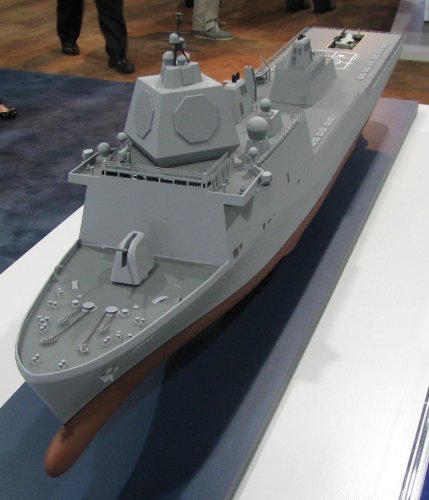 BMD-ship-008-130408-SeaAirSpace-HII-Lisa-Nova-Scotia-2012-647.jpg189.4 KB · Views: 411
BMD-ship-008-130408-SeaAirSpace-HII-Lisa-Nova-Scotia-2012-647.jpg189.4 KB · Views: 411 -
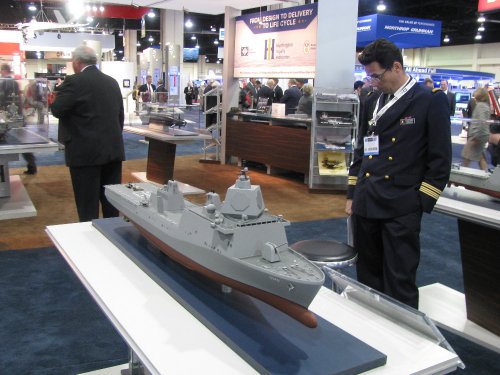 BMD-ship-001-130408-SeaAirSpace-HII-Lisa-Nova-Scotia-2012-641.jpg246.7 KB · Views: 332
BMD-ship-001-130408-SeaAirSpace-HII-Lisa-Nova-Scotia-2012-641.jpg246.7 KB · Views: 332 -
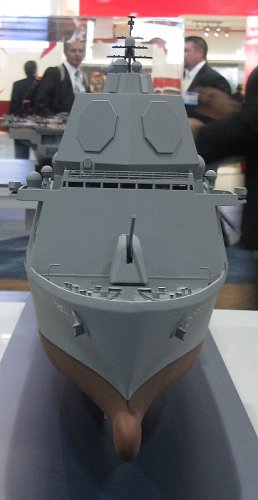 BMD-ship-010-130408-SeaAirSpace-HII-Lisa-Nova-Scotia-2012-6501.jpg120.9 KB · Views: 417
BMD-ship-010-130408-SeaAirSpace-HII-Lisa-Nova-Scotia-2012-6501.jpg120.9 KB · Views: 417 -
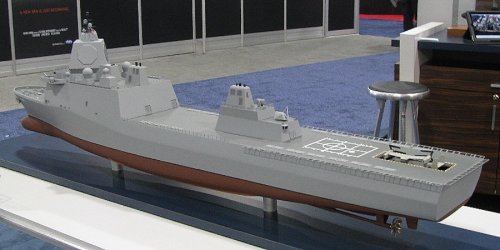 BMD-ship-005-130408-SeaAirSpace-HII-Lisa-Nova-Scotia-2012-644.jpg145.4 KB · Views: 488
BMD-ship-005-130408-SeaAirSpace-HII-Lisa-Nova-Scotia-2012-644.jpg145.4 KB · Views: 488 -
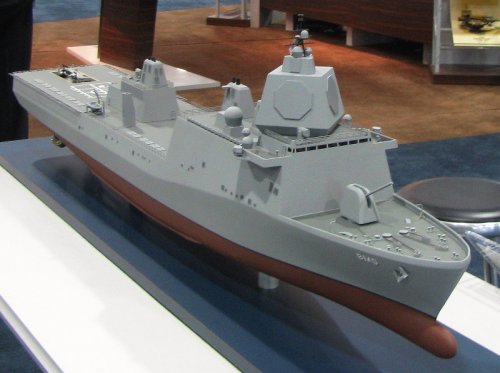 BMD-ship-003-130408-SeaAirSpace-HII-Lisa-Nova-Scotia-2012-642.jpg151.4 KB · Views: 446
BMD-ship-003-130408-SeaAirSpace-HII-Lisa-Nova-Scotia-2012-642.jpg151.4 KB · Views: 446
- Joined
- 21 April 2009
- Messages
- 13,554
- Reaction score
- 7,172
http://www.aviationweek.com/Blogs.aspx?plckBlogId=blog:27ec4a53-dcc8-42d0-bd3a-01329aef79a7&plckPostId=Blog:27ec4a53-dcc8-42d0-bd3a-01329aef79a7Post:560679b8-c876-4db3-8bfc-9594a14bf289
I searched the forum as I thought there must be a BMD ship category did not find it.
I searched the forum as I thought there must be a BMD ship category did not find it.
Model of Huntington Ingalls LPD Flight II Ballistic Missile Defense (BMD) configuration.
Source:
http://www.aviationweek.com/Blogs.aspx?plckBlogId=blog:27ec4a53-dcc8-42d0-bd3a-01329aef79a7&plckPostId=Blog:27ec4a53-dcc8-42d0-bd3a-01329aef79a7Post:560679b8-c876-4db3-8bfc-9594a14bf289
Source:
http://www.aviationweek.com/Blogs.aspx?plckBlogId=blog:27ec4a53-dcc8-42d0-bd3a-01329aef79a7&plckPostId=Blog:27ec4a53-dcc8-42d0-bd3a-01329aef79a7Post:560679b8-c876-4db3-8bfc-9594a14bf289
Attachments
-
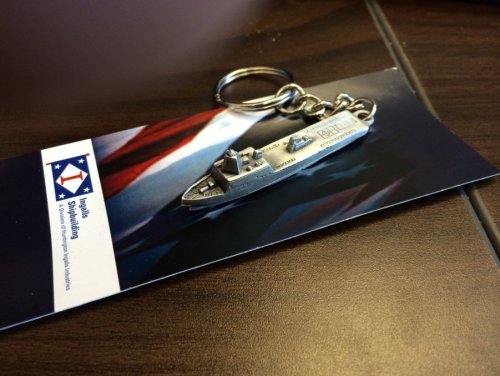 738b3b7e-dad3-4b75-b803-e164ae12586b.Full.jpg185.3 KB · Views: 333
738b3b7e-dad3-4b75-b803-e164ae12586b.Full.jpg185.3 KB · Views: 333 -
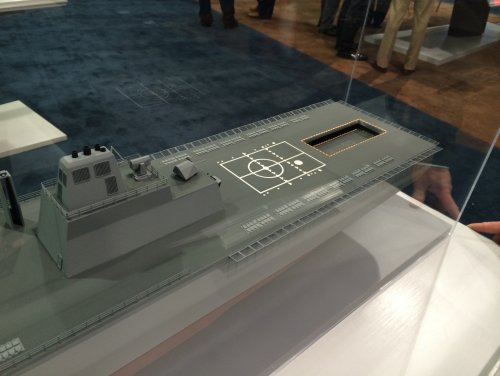 5b63f8a5-2c16-4555-8825-b5fcd059eed4.Full.jpg306.2 KB · Views: 331
5b63f8a5-2c16-4555-8825-b5fcd059eed4.Full.jpg306.2 KB · Views: 331 -
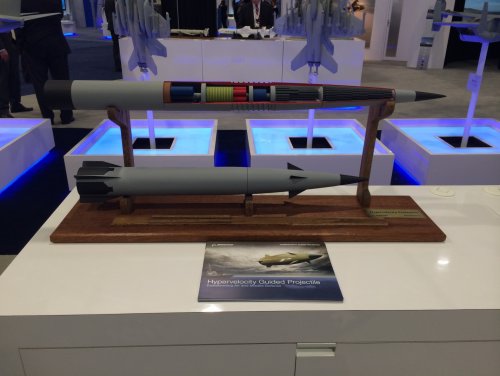 e3522e51-07d2-41b9-a24b-5b7f1483c756.Full.jpg296.1 KB · Views: 325
e3522e51-07d2-41b9-a24b-5b7f1483c756.Full.jpg296.1 KB · Views: 325 -
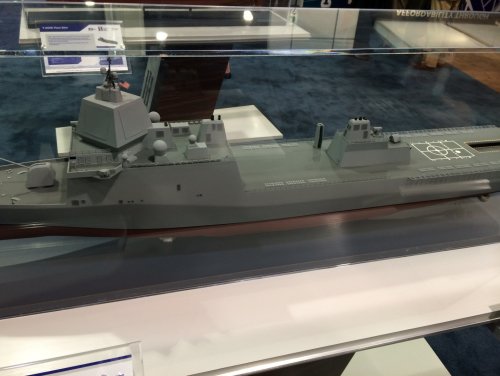 4a9b7557-9fda-46af-a529-a0fafc413ff6.Full.jpg314 KB · Views: 325
4a9b7557-9fda-46af-a529-a0fafc413ff6.Full.jpg314 KB · Views: 325 -
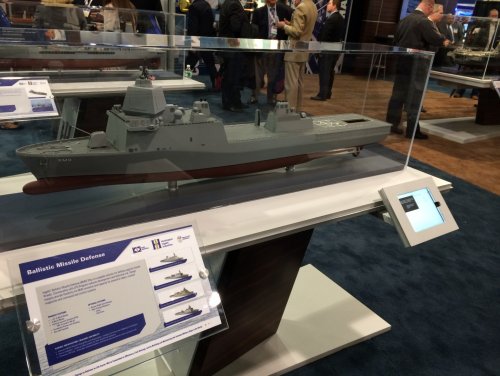 3cd1b1f1-8c61-4e30-989a-391746747dd4.Full.jpg393.8 KB · Views: 295
3cd1b1f1-8c61-4e30-989a-391746747dd4.Full.jpg393.8 KB · Views: 295
- Joined
- 16 April 2008
- Messages
- 9,020
- Reaction score
- 12,729
Funny how designers keep stuffing elevators to the hangar deck onto proposed designs. They don't seem to get how much the USN hates this idea. Every time they have a hangar where the elevator is part of the hangar roof, it leaks.
LPD Based Ballistic Missile Defense Ship
by Ian Williams
Source:
http://missiledefenseadvocacy.org/future-bmd-systems-2/lpd-based-ballistic-missile-defense-ship/
by Ian Williams
Source:
http://missiledefenseadvocacy.org/future-bmd-systems-2/lpd-based-ballistic-missile-defense-ship/
The LPD Based Ballistic Missile Defense Ship (BMD Ship) is a conceptual naval ship design with proven pedigree and potential applications for U.S. homeland and regional missile defense. The ship design is based on the existing LPD 17 hull, and would provide a significantly more capable platform for sea-based missile defense systems than the Arleigh Burke class guided missile destroyers, the current BMD workhorse of the U.S. fleet.
The BMD Ship concept, being developed by Ingalls Shipbuilding, a division of Huntington Ingalls Industries, features a 30-35 foot, multi-faced, S-band radar. A radar of this size provides a significantly larger radar coverage area than the SPY-1 radars integrated into the current Aegis BMD platforms. It also provides more than double the radar coverage of the next generation Advanced Missile Defense Radar (AMDR) planned for DDG 51 Flight III destroyers, and provides strategic level tracking and discrimination, filling in current sensor gaps over the Pacific Ocean and elsewhere. Ingalls Shipbuilding has built more than 65% of the U.S. Navy’s current surface warship fleet.
The BMD Ship could also be adapted to carry missile defense interceptors, and be equipped with other advanced BMD technology such as rail gun or directed energy systems. When not dedicated to BMD missions, the ship could be available for other tasking (e.g. humanitarian assistance/disaster relief/C2/ Lily pad/ and Special OPS).
Current Sensor Gaps
Robust tracking and discrimination of incoming ballistic missiles is vital to not only ensuring a successful missile defense engagement, but also enabling missile defense operators to reduce the number of shots required to ensure intercept. Gaps in coverage pose problems for this process because they allow adversaries to develop missiles that deploy decoys where U.S. sensors have blind spots, making the task of discrimination harder later in flight. If the US warfighter can accurately track the whole flight of a missile in high enough resolution, he can see the separation of missile and decoy, ensuring interceptors are aimed at the threats, and not the decoys or debris. Improved discrimination also allows for better assessment of whether incoming missiles have been destroyed, ensuring effective shot doctrine.
Currently, the radars that the United States has deployed and plans to deploy for discrimination in the Pacific region leave gaps during the early part of the midcourse of ballistic missiles’ flight path. Forward deployed AN/SPY-1 and AN/TPY-2 radar systems track adversary missiles shortly after launch. For regional missile defense, these radars can cover the entirety of the smaller geographic ranges. For missile defense of the United States against ICBM ranged missiles, however, these sensors are quickly overshot. The planned Long Range Discrimination Radar in Alaska would provide coverage for much of the Pacific, but its position in central Alaska leaves a gap in the early midcourse portion of a North Korean missile’s likely flight path. The lack of track coverage in the early midcourse flight of the missile means that discrimination information gained by the AN/SPY-1 and AN/TPY-2 is lost, making the discrimination task more difficult later as the missile moves to its late-midcourse and terminal phases.
BMD Ship Capabilities
Combining the sea-based mobility that was intended for the SBX radar with the S-band radar capability to provide a wider radar picture with discrimination, the BMD Ship could solve the current coverage gaps. The ship design by Huntington Ingalls, based on the design of the LPD 17 San Antonio-class Amphibious Transport Dock, would allow the United States to place up to a 35’ fixed radar closer to adversary missiles on a survivable platform with self-defense capability to maintain a persistent presence. The high speed mobility offered by this sea-based radar platform allows the BMD Ship to be deployed around the world in a domain where the United States enjoys a significant advantage over adversaries.
By basing the design on an existing hull type, the BMD Ship benefits from an active industrial base and a hot assembly line that would allow it to be produced quickly and efficiently. This also means that the ship design has been tested and proven over years of performance in the fleet. The existence of other uses for the hull design also stabilizes the vendor base, ensuring that production of BMD Ships would be scalable to the nature of international threats.
The design of the LPD also allows a great deal of flexibility in terms of what can be deployed on the BMD Ship in addition to its radar. Design options for the ship include a large number of VLS launch tubes for Standard Missile interceptors. In this configuration, the ship would be able to make up for current shortfalls in meeting the demand of Combatant Commands for BMD capable Aegis ships, and free some of these ships for other critical missions. The design also includes substantial power, weight, and volume margin for future BMD system developments and has sufficient space and power for a rail gun or directed energy system. The capacity of an LPD-class hull easily holds the large power system required to create the energy needed for a rail gun or directed energy laser weapon system in the future
Attachments
- Joined
- 16 April 2008
- Messages
- 9,020
- Reaction score
- 12,729
Interesting,. but the design is still odd. I'm not sure what purpsoe the 5-inch gun is serving. It would make more sense to duplicate the RAM plus 57mm lineup forward. More likely economically, just a couple of 30mm guns as on DDG-1000 and in the surface warfare mod for LCS.
It would also make sense to eliminate that elevator. Put a helo pad where the elevator is now and put a hangar forward of it where the pad is in the current design. No need for the complexity of an elevator and there's no need for more than one helo on a ship like this.
It would also make sense to eliminate that elevator. Put a helo pad where the elevator is now and put a hangar forward of it where the pad is in the current design. No need for the complexity of an elevator and there's no need for more than one helo on a ship like this.
- Joined
- 18 March 2008
- Messages
- 3,529
- Reaction score
- 877
TomS said:Interesting,. but the design is still odd. I'm not sure what purpsoe the 5-inch gun is serving. It would make more sense to duplicate the RAM plus 57mm lineup forward. More likely economically, just a couple of 30mm guns as on DDG-1000 and in the surface warfare mod for LCS.
The 5” gun gives you the capability to stonk someone ashore. The BMD ship may be the only asset in a particular area and this gives it the flexibility to respond to varying missions.
TomS said:It would also make sense to eliminate that elevator. Put a helo pad where the elevator is now and put a hangar forward of it where the pad is in the current design. No need for the complexity of an elevator and there's no need for more than one helo on a ship like this.
The LPD17 hull provides lots of volume inside it. Putting the hangar inside the hull enables this volume to be utilised. It also provides enhanced protection for the hangar and moves weight downwards. A superstructure hangar might be an easy thing to build but it means more weight, high up in the ship, and also could obscure radar arcs to the rear of the ship.
Again like the 5” gun there is need for more than just a single mail fetching helo. The BMD ship is likely to be deployed to a BMD threat area and positioned to provide the best coverage. Not necessarily sailing around as part of a battlegroup doing navy stuff. So having several helicopters enables it to provide adequate self defence and to deal with varying missions that may arise in its area of operations.
- Joined
- 18 March 2008
- Messages
- 3,529
- Reaction score
- 877
TomS said:Funny how designers keep stuffing elevators to the hangar deck onto proposed designs. They don't seem to get how much the USN hates this idea. Every time they have a hangar where the elevator is part of the hangar roof, it leaks.
No they don’t. The leaking issue is when the elevator is the floor of the hangar and an additional roof needs to be extended to cover the hangar. This design is not part of the LPD17 BMD ship or some of the many LHD/aircraft carriers around the world with elevators that aren’t on the deck edge.
Ex-Secretary of the Navy John Lehman discussed the Ballistic Missile Defense (BMD) ship concept in a 2012 interview with Defense News:
Source:
http://www.defensenews.com/article/20121007/DEFREG02/310070001?utm_source=twitterfeed&utm_medium=twitte
Q. Would your missile defense ship be based on the DDG 1000 design?
A. There’s also the LPD 17 hull design [used on San Antonio-class amphibious ships]. I didn’t say missile defense destroyer, I said missile defense ship, because to have the kind of power aperture needed for the new radar, there is always a conflict between a deployable battle group ship and a missile defense ship. The latter is in elevated [readiness condition], tied to a specific area. It can’t deploy with the battle group.
To make it affordable, you have to have a hull that’s not a brand-new ship, so it really comes down to between a DDG 1000 and an LPD 17. Both hulls and power capability are quite suitable for the missile defense ship. The basic hull and volume in the LPD 17 can take both the larger missiles and the radar, so the optimal power plant is not the one that’s in it. It would probably be a diesel-based, maybe [combined diesel and gas turbine], or something like that. But that hasn’t been detailed.
Source:
http://www.defensenews.com/article/20121007/DEFREG02/310070001?utm_source=twitterfeed&utm_medium=twitte
- Joined
- 21 April 2009
- Messages
- 13,554
- Reaction score
- 7,172
The 5" Gun is having a family of guided hypervelocity projectiles developed for it as well that will give it even an anti-air/missile/swarming ship/drone capability over a longer range.Abraham Gubler said:TomS said:Interesting,. but the design is still odd. I'm not sure what purpsoe the 5-inch gun is serving. It would make more sense to duplicate the RAM plus 57mm lineup forward. More likely economically, just a couple of 30mm guns as on DDG-1000 and in the surface warfare mod for LCS.
The 5 gun gives you the capability to stonk someone ashore. The BMD ship may be the only asset in a particular area and this gives it the flexibility to respond to varying missions.
TomS said:It would also make sense to eliminate that elevator. Put a helo pad where the elevator is now and put a hangar forward of it where the pad is in the current design. No need for the complexity of an elevator and there's no need for more than one helo on a ship like this.
The LPD17 hull provides lots of volume inside it. Putting the hangar inside the hull enables this volume to be utilised. It also provides enhanced protection for the hangar and moves weight downwards. A superstructure hangar might be an easy thing to build but it means more weight, high up in the ship, and also could obscure radar arcs to the rear of the ship.
Again like the 5 gun there is need for more than just a single mail fetching helo. The BMD ship is likely to be deployed to a BMD threat area and positioned to provide the best coverage. Not necessarily sailing around as part of a battlegroup doing navy stuff. So having several helicopters enables it to provide adequate self defence and to deal with varying missions that may arise in its area of operations.
"What the Navy’s Next Generation Amphibious Ship Could Look Like"
By: Sam LaGrone
November 21, 2014 2:48 PM
Source:
http://news.usni.org/2014/11/21/navys-next-generation-amphibious-ship-look-like
By: Sam LaGrone
November 21, 2014 2:48 PM
Source:
http://news.usni.org/2014/11/21/navys-next-generation-amphibious-ship-look-like
NORFOLK, VA — Huntington Ingalls Industries (HII) has revised its plan to use the hull form of the San Antonio-class amphibious warship (LPD-17) as a candidate for the Navy’s next generation amphibious warship— LX(R), company officials outlined to USNI News on Tuesday.
HII has pitched variants of the LPD-17 hull for at least two years to the Navy for everything from a ballistic missile defense (BMD) platform to a candidate for LX(R) as LPD Flight II.
HII’s new Flight IIA — mocked up by HII earlier this year — modifies the original LPD-17 original design by removing some of the higher end capabilities of the San Antonio and creating a so-called amphibious truck to replace the existing class of aging Whidbey Island and Harpers Ferry 16,000-ton landing ship docks (LSD-41/49).
Though the concept isn’t news, last month’s revelation that the San Antonio hull will be the basis for LX(R) — according to a memo from the Secretary of the Navy Ray Mabus — and HII’s ongoing consultation with the service with the design work for the new ship gives greater credence to the company’s plan.
The largest improvement in capability will be to the ship’s communication and aviation ability.
The current LSDs have a minimal command and control (C2) capability – the ability to communicate with other U.S. military forces and coordinate different types of aircraft and smaller vessel — and no native ability to host and maintain the aircraft of the trio of ships that make up the Navy’s Amphibious Ready Groups (ARGs).
At their inception, the LSDs “was really just a truck to always be married up with ARG and never go away from it,” carrying vehicles and landing craft as a compliment for the ARG LPD and big deck amphibious warships, Marine Maj. Gen. Robert S. Walsh, Director Expeditionary Warfare Division (N95), told USNI News on Wednesday.
However, modern operations have required the ARGs to split up and undertake different missions — at times hundreds of miles away from the other ships in the group.
The LSDs are currently the weakest in C2 and aviation maintenance arena of the trio.
HII’s LPD Flight IIA features a hangar smaller than the one on the LPD-17 capable of stowing two MV-22 Ospreys and eliminates the composite masts of the current San Antonio-class design.
The LX(R) will be much bigger than the ships it will be replacing — displacing about 7,000 more than the current LSDs at 23,470 tons, HII officials told USNI News on Tuesday.
Instead of the four Colt-Pielstick diesel engines, HII’s model reduces the prime mover count to two unspecified main propulsion diesel engines (MPDE).
The Flight IIA retains about half of the medical spaces on the LPD. Company officials also said the current iteration would feature two spots for the Navy’s LCAC hovercraft or one utility landing craft (LCU) — which is in line with the Navy’s current thinking for requirements for the LX(R), USNI News understands.
Other changes include reducing the troop capacity from 800 to 500 with a crew of about 400 sailors.
Though HII is original designers and builders of the LPD-17 ships, they are not guaranteed the design and construction contract for the new LX(R) ship class. General Dynamics NASSCO in San Diego, Calif. has also helped the Navy in its current push to lower the cost at the start of the acquisition process and is considered likely to bid on the final work.
“Both HII and NASSCO were helping with ideas on how to drive cost down,” Walsh said.
“When I say competition, we’d look at anyone who could compete and plan it, but those would certainly be two shipyards that would have the ability to compete in this environment.”
The Navy’s frontend analysis of alternatives process for LX(R) has been described as, “the best ship design conversation we’ve had in a long time inside the government,” NAVSEA chief Vice Adm. William Hilarides said in May.
HII officials didn’t give USNI News a cost estimate for their version, but according to past information from the Navy a San Antonio LX(R) could cost about $1.64 billion for the lead ship with follow-ons costing about $1.4 billion for a total of 11 ships.
However, recently the service has been reluctant to put a cost figure on the LX(R) program.
Attachments
I should have posted the article in addition to the pictures back in the day.
"Introducing the Ballistic Missile Defense Ship"
Apr 11, 2014 by Daniel Katz in Ares
Source:
http://aviationweek.com/blog/introducing-ballistic-missile-defense-ship
"Introducing the Ballistic Missile Defense Ship"
Apr 11, 2014 by Daniel Katz in Ares
Source:
http://aviationweek.com/blog/introducing-ballistic-missile-defense-ship
Among the many striking displays at the recent Navy League Sea-Air-Space Exposition was this marvel -- an amphibious warfare ship adapted for Ballistic Missile Defense (BMD), with three times the radar size and missile capacity of current BMD vessels, as well an electromagnetic rail gun that can launch shells to the edge of space.
The concept from Huntington Ingalls Industries’ (HII) is based on the hull of the LPD-17 San Antonio Class, a component of the three-ship “Amphibious Ready Groups” that stage Marines at forward, sea-based positions. In this incarnation, HII has removed the Marine’s berthing, vehicles, helicopters and landing craft, and installed air defense equipment with greater range and capacity than any ship in the fleet.
Atop the superstructure is a massive S-band phased array radar, over 21 feet on each side. Compare that to the 12.5 ft. diameter of the SPY-1 radars aboard Ticonderoga Class Cruisers and Arleigh Burke Class Destroyers. For radars, larger size means greater range and better resolution and these arrays have three times the area of those which equip current BMD vessels.
Starting behind the superstructure and continuing along the periphery to the stern is a vertical launch system (VLS) with 288 cells to carry surface to air missiles (SAMs), Tomahawk cruise missiles or Vertical-launch Anti-submarine rockets (VLAs). For comparison, Ticos have 122; later Burkes 96 and earlier Burkes 90. So, that’s triple the average missile load to start, with plenty of room to install more. Plus, the ship is taller than the surface combatants, which means it can hold future missiles of greater length and range.
Forward of the superstructure, you see what looks like a standard five inch gun, the kind one finds on the Ticos and Burkes. But an engineer responsible for this design explains that’s not what it represents. In fact, it’s an electromagnetic rail gun.
At least two other companies at the Expo exhibited their work on rail guns. The contractors speak of equipping surface combatants with 30+ mega joule (MJ) systems sometime in the 2020s. Elevated for maximum range, those barrels can throw shells a hundred miles away. Elevated higher, they can shoot projectiles to the edge of the atmosphere and possibly beyond.
That capability has caught the attention of missile defense thinkers because the shells might be able to intercept incoming warheads from ballistic missiles. With muzzle velocities of Mach 7, shells accelerated by 30MJ weapons would retain enough speed to engage re-entry vehicles as they fall back into the atmosphere, and possibly enough to chase maneuvering re-entry vehicles (MaRVs) trying to dodge them.
They’re also relatively cheap. Part of the difficulty of missile defense is economic. BMD interceptors like SM-3 often cost several times more than the missiles against which they defend. Using rail guns for BMD could flip that ratio, allowing multiple rounds to be economically expended on a single target. Even if a MaRV has greater kinetic energy than each round – which would confer a maneuvering advantage – it would face difficulty avoiding multiple interceptors while maintaining a course that ends at its target. This is particularly true if when the rounds approach they explode into clouds of hypersonic shards, which is what Boeing has in mind:
Yet another reason rail guns may interest the BMD community is the emerging threat posed by hypersonic glide vehicles (HGVs), such as the one China tested in January. Rather than entering space like normal ballistic missiles, HGVs achieve great speed from their boosters but separate earlier, staying low enough to glide on the air remaining in the stratosphere. Accepting some drag for greater lift, these warheads fly farther than if on a higher trajectory. The benefit is more range and a flight path too low to be intercepted by exo-atmospheric kill vehicles – such as the ones which equip the SM-3 and other mid-course BMD interceptors. The downside is when the warhead nears its target, it has less speed and altitude and is therefore more easily intercepted by low-tier interceptors, including potential rail guns.
While offering greater BMD capability than any other ship operating or planned, the LPD BMD could still provide versatility. The missile cells can launch Tomahawks at land targets. While not currently intended for anti-submarine warfare, acoustic equipment could be added, VLAs can be carried, and the ship can embark helicopters. They could also retain some of their Marine equipment to continue providing amphibious warfare capability.
HII generated this concept about a year ago, and they’re not the only one’s thinking about it. Noted naval analyst Norman Polmar has also spoken of integrating air defense equipment onto amphibious warfare vessels. The two qualities one needs to improve BMD capability are larger radars and more missile cells; features which call for a bigger ship, like an amphib.
The number of missile cells also harkens back to the Arsenal Ship, a notion which floated around the pages of defense publications in the 1990’s. The idea was to design a stealthy, low-visual signature ship which would just barely extend above the water and hold 500 cells for tomahawks, providing unmatched firepower wherever it travelled. The idea came to partial fruition with the conversion of four Ohio class submarines to SSGNs. In place of 24 Trident nuclear ballistic missiles, these subs now carry 154 conventional Tomahawks and comprise 60% of the Navy’s cruise missile strike force. However, they are set to begin retiring towards the end of the decade. The current solution is to add more Tomahawk launchers to the next version of Virginia Class attack subs. It seems LPD BMD could help here as well, as it is conceptually a cross between an amphib, a Burke and the arsenal ship.
But the big difference in feasibility between the SSGNs and the LPD BMD is cost. The four subs had already been bought, except for the Tomahawk equipment. To field LPD BMD vessels, the US would have to pay for new ships, as well as new radars.
How much would it have to pay? So much nobody has asked for a specific estimate. One can make an educated guess though. The last LPD 17 the US bought cost around $2.1B. The most expensive addition to the basic design would be the radar and associated combat system. Aegis combat systems and their SPY-1 radars cost approximately $222M apiece for FY15. However, an engineer responsible for the LPD BMD design states a better analogy would be the “Cobra Judy,” a shipboard radar the US uses to conduct surveillance on foreign ballistic missile launches. Cobra Judy and its carrying vessel costed ~$1.7B for research and construction of one system. Building multiple ships might reduce the cost, but there would also be research and development to conduct on the new radar, which could increase the total cost of each ship significantly. Throw in the other combat systems and $4B seems like a reasonable ball-park, which would make LPD BMD the third most expensive ship class on record, after the Ford Class Carrier and Ohio Ballistic Missile Submarine Replacement.
At that cost, it’s hard to imagine the US ever buying more than a few, but that may be all the military needs. While no ship can be in two places at once, there are only a couple of theaters that require such great BMD defenses. Like the SSGNs, a handful of LPD BMDs could vastly increase capability in the couple of regions where the threat is greatest. Each LPD BMD accommodates up to 288 interceptors and has the space to carry more. China’s entire ballistic missile force numbers approximately 1100.
Unfortunately, there’s not enough money in the budget right now even for a handful. Too bad. It’s a fascinating concept, but in today’s fiscal environment, that’s probably all it’ll ever be … that, and the world’s coolest key chain
- Joined
- 4 July 2010
- Messages
- 2,398
- Reaction score
- 2,709
That concept doesn't have a 5" gun, it has a 32mj railgun in the forward turret. With the intent that it could engage ballistic targets as well as being used for surface/land attack.TomS said:Interesting,. but the design is still odd. I'm not sure what purpsoe the 5-inch gun is serving. It would make more sense to duplicate the RAM plus 57mm lineup forward. More likely economically, just a couple of 30mm guns as on DDG-1000 and in the surface warfare mod for LCS.
donnage99
ACCESS: Top Secret
- Joined
- 16 June 2008
- Messages
- 1,279
- Reaction score
- 618
TomS said:Interesting,. but the design is still odd. I'm not sure what purpsoe the 5-inch gun is serving. It would make more sense to duplicate the RAM plus 57mm lineup forward. More likely economically, just a couple of 30mm guns as on DDG-1000 and in the surface warfare mod for LCS.
It would also make sense to eliminate that elevator.
If you compare the foward facing gun with the rear facing gun in the back, you can see that the gun is much larger than the standard 5 inch. It's a railgun designed to shoot down incoming missiles, possibly hypersonic gliding vehicles that china is developing.
- Joined
- 16 April 2008
- Messages
- 9,020
- Reaction score
- 12,729
OK, Railgun makes a bit more sense, although I'm not sold on railguns for long-range missile defense.
This is not a ship that would be forward-staged. Its main purpose would be as a gap-filler for continental BMD (an SBX alternative), which means it needs to sit well back from the potential launch sites. The documentation talks about how typical forward-based BMD assets like AEGIS ships are too forward and are over-shot by long-range missiles, so this ship would not be anywhere close to shore. And it would be far too high-value, low-density to be left without an escort.
This is not a ship that would be forward-staged. Its main purpose would be as a gap-filler for continental BMD (an SBX alternative), which means it needs to sit well back from the potential launch sites. The documentation talks about how typical forward-based BMD assets like AEGIS ships are too forward and are over-shot by long-range missiles, so this ship would not be anywhere close to shore. And it would be far too high-value, low-density to be left without an escort.
donnage99
ACCESS: Top Secret
- Joined
- 16 June 2008
- Messages
- 1,279
- Reaction score
- 618
TomS said:OK, Railgun makes a bit more sense, although I'm not sold on railguns for long-range missile defense.
This is not a ship that would be forward-staged. Its main purpose would be as a gap-filler for continental BMD (an SBX alternative), which means it needs to sit well back from the potential launch sites. The documentation talks about how typical forward-based BMD assets like AEGIS ships are too forward and are over-shot by long-range missiles, so this ship would not be anywhere wlose to shore. And it would be far too high-value, low-density to be left without an escort.
The railgun is designed to defend against anti-ship ballistic missile or cruise missile that is aimed either at it or the fleet. Especially with hypersonic glide vehicles that fly too low for current ship based bmd missiles to intercept effectively. It's also about cost efficiency and space. Railgun ammo is both much cheaper and take less space.
donnage99 said:TomS said:OK, Railgun makes a bit more sense, although I'm not sold on railguns for long-range missile defense.
This is not a ship that would be forward-staged. Its main purpose would be as a gap-filler for continental BMD (an SBX alternative), which means it needs to sit well back from the potential launch sites. The documentation talks about how typical forward-based BMD assets like AEGIS ships are too forward and are over-shot by long-range missiles, so this ship would not be anywhere wlose to shore. And it would be far too high-value, low-density to be left without an escort.
The railgun is designed to defend against anti-ship ballistic missile or cruise missile that is aimed either at it or the fleet. Especially with hypersonic glide vehicles that fly too low for current ship based bmd missiles to intercept effectively. It's also about cost efficiency and space. Railgun ammo is both much cheaper and take less space.
The BMD Ship would not deploy with a battlegroup. Per John Lehman, the power aperture needed for the new radar would conflict with the battlegroup. The BMD Ship is tied to a specific area providing homeland or regional ballistic missile defense. I believe that TomS's comment is related to the defense of the BMD Ship. Would the railgun and two helicopters provide sufficient self-defense for the BMD Ship? Or would more defense systems need to be installed or escorts need to be assigned to the BMD Ship? How many of the 288 VLS cells would be devoted to missiles for defending the BMD Ship?
- Joined
- 3 June 2011
- Messages
- 17,871
- Reaction score
- 10,927
Triton said:donnage99 said:TomS said:OK, Railgun makes a bit more sense, although I'm not sold on railguns for long-range missile defense.
This is not a ship that would be forward-staged. Its main purpose would be as a gap-filler for continental BMD (an SBX alternative), which means it needs to sit well back from the potential launch sites. The documentation talks about how typical forward-based BMD assets like AEGIS ships are too forward and are over-shot by long-range missiles, so this ship would not be anywhere wlose to shore. And it would be far too high-value, low-density to be left without an escort.
The railgun is designed to defend against anti-ship ballistic missile or cruise missile that is aimed either at it or the fleet. Especially with hypersonic glide vehicles that fly too low for current ship based bmd missiles to intercept effectively. It's also about cost efficiency and space. Railgun ammo is both much cheaper and take less space.
The BMD Ship would not deploy with a battlegroup. Per John Lehman, the power aperture needed for the new radar would conflict with the battlegroup. The BMD Ship is tied to a specific area providing homeland or regional ballistic missile defense. I believe that TomS's comment is related to the defense of the BMD Ship. Would the railgun and two helicopters provide sufficient self-defense for the BMD Ship? Or would more defense systems need to be installed or escorts need to be assigned to the BMD Ship? How many of the 288 VLS cells would be devoted to missiles for defending the BMD Ship?
Still, you wouldn't want an enemy SSN putting a couple torpedoes in its side so you'd still need some escorts.
sferrin said:Still, you wouldn't want an enemy SSN putting a couple torpedoes in its side so you'd still need some escorts.
That affects the make it affordable argument if you have to assign escorts to the BMD Ship.
Would the missile of choice for the BMD Ship be the Raytheon RIM-161 Standard Missile 3 (SM-3) and could we afford 288 of them? It seems like the cost of the missiles to arm the ship would be greater than the cost of the ship.
- Joined
- 3 June 2011
- Messages
- 17,871
- Reaction score
- 10,927
Triton said:sferrin said:Still, you wouldn't want an enemy SSN putting a couple torpedoes in its side so you'd still need some escorts.
That affects the make it affordable argument if you have to assign escorts to the BMD Ship.
True but you can't leave it unescorted either.
bobbymike said:They should add an Intermediate Range Prompt Global Strike variant when the SSGNs go away there is a huge hole in Naval strike.
Remotely controlled like arsenal ship?
- Joined
- 21 April 2009
- Messages
- 13,554
- Reaction score
- 7,172
Fully manned so it 'could' operate alone is areas of world that don't threaten capital ships (like most of the oceans) Park one off the coast of Africa/Yemen to support SepcOps teams on shore with rapid strike capabilities.Triton said:bobbymike said:They should add an Intermediate Range Prompt Global Strike variant when the SSGNs go away there is a huge hole in Naval strike.
Remotely controlled like arsenal ship?
- Joined
- 4 July 2010
- Messages
- 2,398
- Reaction score
- 2,709
The loadout would not be single-type. There would be a mix of ESSM, SM-2, SM-3, and SM-6. There may even be some Tomahawks and VL-ASROCs simply to hedge bets.Triton said:Would the missile of choice for the BMD Ship be the Raytheon RIM-161 Standard Missile 3 (SM-3) and could we afford 288 of them? It seems like the cost of the missiles to arm the ship would be greater than the cost of the ship.
- Joined
- 16 April 2008
- Messages
- 9,020
- Reaction score
- 12,729
Yep, and that's half the problem with the idea. They can't decide what they want it to do and so tried to make it do some of everything. But that's not affordable -- filling a load of 288 VLS cells means stripping missile defense and other weapons from the rest of the fleet. And trying to use it for non-BMD missions as well means a lot of tension between taskings and how far away from its BMD station you can afford to send it.
If you want to support SOCOM in otherwise low-threat ragions, build a couple more Afloat Forward Staging Base ships instead, for a fraction of the cost. If you need Tomahawk as part of that support, you probably want a destroyer there anyway, to hedge your bets.
If you want to support SOCOM in otherwise low-threat ragions, build a couple more Afloat Forward Staging Base ships instead, for a fraction of the cost. If you need Tomahawk as part of that support, you probably want a destroyer there anyway, to hedge your bets.
- Joined
- 18 March 2008
- Messages
- 3,529
- Reaction score
- 877
sferrin said:Still, you wouldn't want an enemy SSN putting a couple torpedoes in its side so you'd still need some escorts.
No need for other surface ships to provide anti-submarine escort. With the LPD-17 hull and large flight deck it can operate a reasonable group of anti-submarine helicopters. Offboard queuing capability would be provided by theatre level surface surveillance (BAMS) and underwater surveillance (SOSUS). There would probably be one single escort however. But it would be underwater. And combined with the above capabilities and the 'defend your ground' nature of a BMD ship deployment be more than adequate against anything the submarines of the Soviet Union, ahh I mean Russia, could throw at it.
- Joined
- 3 June 2011
- Messages
- 17,871
- Reaction score
- 10,927
Abraham Gubler said:sferrin said:Still, you wouldn't want an enemy SSN putting a couple torpedoes in its side so you'd still need some escorts.
No need for other surface ships to provide anti-submarine escort. With the LPD-17 hull and large flight deck it can operate a reasonable group of anti-submarine helicopters. Offboard queuing capability would be provided by theatre level surface surveillance (BAMS) and underwater surveillance (SOSUS). There would probably be one single escort however. But it would be underwater. And combined with the above capabilities and the 'defend your ground' nature of a BMD ship deployment be more than adequate against anything the submarines of the Soviet Union, ahh I mean Russia, could throw at it.
I thought SOSUS was mothballed? Also, with today's networked forces, I'd think something like Sea Lance would be attractive again. (Preferably with something more modern than a Mk46/54 on the end.)
- Joined
- 16 April 2008
- Messages
- 9,020
- Reaction score
- 12,729
They may have killed SOSUS, but there are a bunch of sensors lumped together under Integrated Underwater Surveillance System and run by Commander, Underwater Surveillance. They include the remaining SURTASS ships, some dual-use ocean surveillance sensors that have both military and scientific applications, some theater-level deployable sensors that only get mentioned very quietly, and a bunch of seafloor sensors that seem to have been fielded around Japan and China with very little fanfare. They've built some new shore stations in recent years, so they must be getting data from somewhere.
- Joined
- 3 June 2011
- Messages
- 17,871
- Reaction score
- 10,927
I thought that the USN, in their infinite wisdom, had decided to get rid of their SURTASS ships as well? I know there is still at least one older class still plugging along but I thought their days were numbered. The Impeccable class, that was suppose to pick up the torch, was killed at 1 unit instead of the 6 they were going to buy. And as far as I know there are no plans for more SURTASS ships for the foreseeable future.
- Joined
- 16 April 2008
- Messages
- 9,020
- Reaction score
- 12,729
I don't know the future plans, but there are the five survivors of the Victorious and Impeccable classes and most of them have gotten new sonars (LFA) within the past few years. The youngest Victorious is only 15 years old (in service) so she should be able to last a good while longer.
- Joined
- 4 July 2010
- Messages
- 2,398
- Reaction score
- 2,709
The long range plan is for a deployable unammaned systems to take over a lot of those roles. A "SOSUS that you bring with you" is pretty high on the priority development list, plus there are projects like ACTUV expanding the envelope.
BMD ship configurations :
http://www.huntingtoningalls.com/single-face-slewable-array/
http://www.huntingtoningalls.com/ballistic-missile-defense-ship/3-fixed-arrays-23/
http://www.huntingtoningalls.com/ballistic-missile-defense-ship/3-fixed-arrays-30/
http://www.huntingtoningalls.com/single-face-slewable-array/
http://www.huntingtoningalls.com/ballistic-missile-defense-ship/3-fixed-arrays-23/
http://www.huntingtoningalls.com/ballistic-missile-defense-ship/3-fixed-arrays-30/
Attachments
Similar threads
-
-
-
Sea-based Anti-Ballastic Missile Intercept System (SABMIS)
- Started by Triton
- Replies: 69
-
-
Navy Struggles to Fund SSBN(X), Destroyers, and cost overruns on CVN 78
- Started by Triton
- Replies: 19

